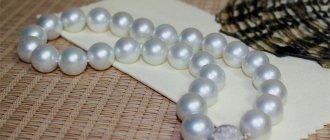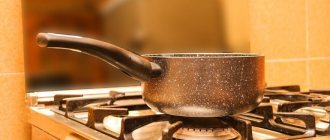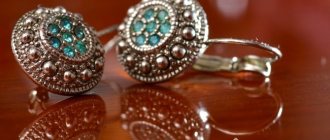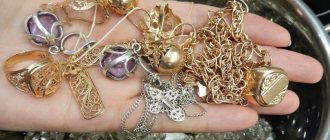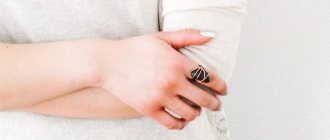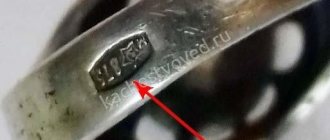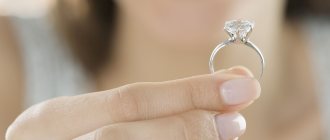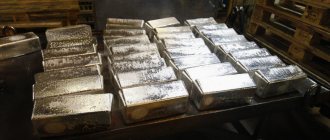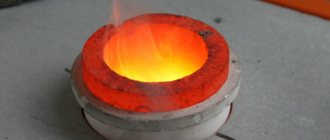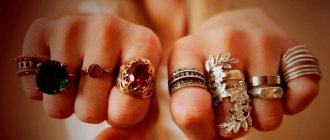Pearls are a piece of jewelry that will never go out of date. From the very beginning of our era to this day, this is the thing that will give purity and tenderness to a girl, and charm and mystery to a woman. But this luxurious pearl requires delicate treatment and careful care, so the following information will come in handy for all lovers of these gifts of nature. How to clean pearl jewelry at home and prevent damage to your favorite necklace, bracelet, ring or earrings - all useful tips are collected here.
Features of pearl products
Pearl is a mineral that is formed in the shells of mollusks as a result of the entry of a foreign body. Natural is extracted from the bottom of the sea or river, and the so-called cultivated is grown artificially. A special type of pearl is soufflé. This mineral is hollow inside. It requires even more careful treatment when cleaning and wearing.
The lifespan of pearl beads is relatively short - no more than 1.5 hundred years. Over time, they may develop a yellowish layer, cracks, or black spots. And yet, such defects can be prevented and the life of the product can be extended. The main thing is to regularly care for your pearls.
Why do you need to care for pearls?
There are three types of pearls:
- natural, created by the sea;
- cultivated, in conditions close to marine ones;
- artificially grown (freshwater).
When a grain of sand enters the shell, the oyster begins to produce special substances that coat it. It is the layers of these substances that create the shine of mother-of-pearl.
“Sea stone” does not tolerate acids and ammonia. It has high impact resistance, but can be damaged if it hits other jewelry.
On the Moss scale, the hardness of a marine formation (resistance to damage) is rated from 3 to 4. While the same indicator for house dust is 7. Therefore, wiping a stone with a dry cloth means causing irreparable harm to it.
What can't be used?
When you want to quickly clean your pearls, you can use aggressive products that can easily deal with contamination. But in 90% of cases they completely ruin the fragile pearl. After a couple of sessions of such cleaning, the beads will sharply lose their appearance: they will stop shining, turn yellow, lose their pearlescent coating, become scratched or even crack.
Therefore, remember that pearls do not tolerate:
- Abrasive powders. They can easily scratch the delicate top layer. Pearls will fade instantly.
- Solvents. Even nail polish remover without acetone does not cancel the rule.
- Vinegar. And also other acids easily dissolve the mineral. Even water with the addition of these substances can harm pearls.
- Alkaline products. He will not even tolerate soda paste, which is considered more gentle. This also includes solid soap.
- Alcohol. Including ammonia, which is too aggressive for pearl products.
- Ultrasound. It is better to bypass this method, especially this rule applies to freshwater and cultured pearls, since their coating is much thinner than that of natural ones.
- Detergents for dishes, windows, furniture. Their components can be hazardous to organic minerals. Be careful!
- Hot water. To clean mother of pearl, use warm or room temperature water. In this case, it is better to take drinking water and not from the tap.
- Synthetic sponges and hard brushes. It is better to use cotton swabs, cosmetic brushes or applicators instead. Of course, clean.
- Metal sharp objects. Never use a knife to remove dirt. Especially soufflé pearls. An ordinary mineral can be severely scratched, but a soufflé can simply be crumbled with just one awkward movement.
What not to clean pearls
A gemstone easily loses its pearlescent layer. Therefore, the use of any aggressive chemicals is unacceptable. Solvents such as nail polish remover are especially dangerous. In addition, the use of the following means is prohibited:
- alcohol;
- soda;
- vinegar;
- abrasive powder;
- synthetic sponges.
Ultrasound poses a serious threat to jewelry. The use of hard brushes is also contraindicated, as they severely scratch the surface, removing mother of pearl.
Cleaning products
To clean mother-of-pearl items, you usually do not need to contact a professional. You can clean your pearls yourself at home, and you don’t even have to run to the store.
Soap solution
A great option for cleaning pearl beads. Prepare two plastic bowls. Fill one with clean water, and the second with a soap solution (for 1 glass of water, 1 teaspoon of liquid soap). The water in both containers should be at room temperature.
Place the product in a bowl of soap for 30 minutes. If necessary, you can gently clean the pearls with a soft sponge or cloth. Afterwards, rinse several times in clean water and wipe with a cloth. But even if you think that you have wiped the pearls dry, still place them on a horizontal surface for another half hour, spreading a soft cloth. Do not leave the pearl thread to dry in a vertical position - it will easily stretch.
You can also clean the stones with a cotton pad soaked in soapy water. Then wipe with a damp disc and leave until dry.
Starch
But starch can easily help whiten pearls. In addition, it will collect excess moisture, which harms the mineral:
- Pour potato starch onto a velvet or suede fabric, place the product on it and sprinkle more on top. Wrap the remaining piece of velvet around the jewelry and massage it gently in your hands for a few minutes. After this, rinse it in clean water and dry it, leaving it on a dry cloth for half an hour.
- There is another method. But it is more suitable for low pollution. Place the pearls in a box or plastic jar with starch and close the lid tightly. Shake it for a few minutes and then rinse and dry your precious item.
Salt
Salt will cleanse pearls well. The main thing is to use small ones, and you can simply grind the large ones. The mineral will be liked even more by sea salt:
- Make a saline solution: per glass of warm water you need 1 tbsp. l. salt. Leave the pearl necklace in it for half an hour. Then carefully clean each bead with your fingers and rinse in water at a temperature of 20-25°C. Leave to dry for 30 minutes on a soft, dry cloth. To make the pearls shine, after drying, you can wipe them with a piece of velvet or suede.
- Place the pearl product in a nylon sock and pour salt into it, sparingly. Gently massage it with your fingers for a few minutes. Then remove, rinse under water and dry. Do not use this method if the pearls are framed in metal or decorated with other stones. Parts may scratch the beads. If there is still a chance of damaging the pearl, then do not massage it with your fingers, but hold the bag under a tap with warm water until the salt disappears. This way the impact will be much softer.
Sunbath
They say that direct sunlight is harmful to pearl jewelry. But sometimes it is permissible to use this method. For example, when you want to bleach pearl beads. The main thing is not to overdo it with sun exposure. A few hours will be enough. Rotate the beads periodically and then cover with a soft cloth. If necessary, the procedure can be repeated the next day.
Special paste
Not the cheapest, but the safest option. Jewelry paste will not only clean the pearl from dirt and plaque, but will also make it shine again. You just need to apply a little product on a soft napkin, wipe the pearls with it, and then remove the remaining paste with a dry and clean napkin. After this, you can also treat the pearls with velvet or suede to make them shine.
This paste is sold only in specialized stores. It’s unlikely that you’ll find one like this in an ordinary household store. At the same time, jewelry paste is available for different types of products. Before purchasing, read the label - the product should be specifically designed to care for mother-of-pearl.
Advice! You should not clean pearls with jewelry paste very often. This can reduce the service life of the decoration significantly. For regular care, it is better to use milder products.
How to store pearl products: do's and don'ts
Natural pearls are demanding and capricious. But in return for careful treatment and storage, they will delight you with pure radiance and long service. Remember, despite the fact that pearls are called organic stones, they are not nearly as durable. Its hardness rating on the Mohs scale does not exceed 4, which means that the beads must be protected from falls from heights. The following tests will become unnecessary and dangerous:
- high temperatures;
- dry and dirty air;
- direct sunlight;
- by sea or ocean;
- chlorinated pool water.
All this will negatively affect the appearance and life expectancy of pearls. Therefore, a swimming pool, solarium, sauna, swimming on the beach wearing pearl jewelry are not considered.
The best place to store a pearl is on the owner's body. Despite their fastidiousness, mother-of-pearl beads love to contact a person, returning love and devotion in kind. The only thing is that before going to bed, it is better to remove the product, first removing traces of wear with a damp cloth.
Another thing is jewelry for special occasions. You can’t wear them every day even if you want to, which means you need to know exactly under what conditions they will be stored without the risk of damage. The ideal option is a wooden or stone box. Plastic bags or linen bags will not work. Inside the box, the product should be stored on a pillow made of natural fabric.
It is important that the room where pearls are stored is sufficiently humid. Created in the depths of the sea (river), the mother-of-pearl “tear” does not tolerate dry air. Therefore, if it is not possible to maintain the desired level of humidity automatically using a humidifier, just make sure that there is a vase filled with fresh water next to the box at all times.
From time to time, jewelry with pearls should be taken out of the box, worn for a short time, at least at home, and rubbed with velvet or wool.
How to restore shine to stones?
Refined olive oil can restore the shine of pearls. Other fats can cause the opposite effect - not restore shine, but attract even more dust. And pay attention to the expiration date - expired oil can spoil the mineral.
Pour some oil onto a cotton pad and rub it pearl by pearl. Then clean the beads with a lint-free cloth, removing any residue. Try not to overdo the quantity. Oil can get into the hole and dirt will accumulate there faster.
Cleaning pearls in a setting
Jewelry combined from different types of metals with pearls looks especially interesting. But caring for them is even more difficult. For each element you need to choose your own tool. And at the same time try not to damage the neighboring one. Usually pearls are framed in precious metal. Let's deal with each in order.
Golden
There are two ways to clean pearls in gold:
- Soak a cotton swab in ammonia and gently clean the metal element.
- Apply baby powder or cosmetic powder to a piece of flannel and buff the metal piece.
Important! Gold gets dirty quite quickly, so if you wear it constantly, you need to clean items with it once every two weeks.
Silver
But silver can be cleaned less often - about once every two months. For this type of metal there is the following instructions:
- The soda must be quenched with vinegar or ammonia and applied to the silver. Then, while the metal is soaking, wipe the pearls with a cloth soaked in soapy water. Wait another half hour and rinse the product with warm water.
- If the silver parts have darkened, it is better to take the precious item to a jeweler. It is better to correct such a defect in the hands of a professional.
- It may well be that after cleaning, some dirt remains between the metal and the pearl. Especially a lot accumulates on earrings and rings. A wooden toothpick will help remove such stains - it will not scratch the pearls.
- If metal cleaner does come into contact with your pearls, immediately rinse the pearls in warm water.
What is not recommended to do
Pearls, after several years, lose their original color - they become cloudy. This happens because the gem contains only 2% liquid. Because of this, at high temperatures it dries out, exfoliates, and at high humidity it becomes faded and dull. A very whimsical gem.
But there are some rules that will help protect it from loss of beauty. But first you need to know what you should never do with pearl jewelry:
- Clean with a toothbrush. This item has a hard coating that will ruin the surface of the stone. Cleaning with detergents, soda, and vinegar is also not allowed.
- Spray the decoration with perfume or eau de toilette. If these perfumes come into contact with the surface of the necklace, the color of the pearls will turn reddish.
- Take a bath in them.
Tips for care and use
Caring for pearls is not only delicate cleaning, but also careful wear and proper storage. It is worth remembering the following rules, and you will be able to pass on precious things from generation to generation:
- You should not store pearls in a pile with other jewelry. It is better to put it in a box lined with velvet. Dust settled on it can leave small cracks, causing the mineral to quickly lose its shine.
- You need to keep pearls in a place with humid air. Only 2% of pearls contain water. Accordingly, dry air can easily damage it, and it will begin to peel off. However, excess moisture can also contribute to turbidity of the mineral. Near the place where the pearl item lies, it is enough to place a glass of water.
- Prolonged exposure to the sun is also dangerous for pearls - they can turn yellow and tarnish.
- Take off your pearls before playing sports. Sweat contains acids that easily corrode the pearlescent layer.
- Cosmetics, perfumes and hairspray cause severe damage to the mineral. That is why a precious item should be worn only after you have applied cosmetics to your skin and hair. At the same time, wait until creams, perfumes and other products are completely absorbed into your skin. Otherwise, a coating will appear on the pearls.
- Try to clean your pearls with soap and water after each wear. This will make it easier to avoid professional restoration.
- Do not store pearl beads hanging. The thread stretches and thins very easily. By the way, it should be changed every three years.
- Cleaning the mineral with a dry cloth is a bad idea. Dust particles on it will scratch the pearls.
- Wear mother-of-pearl jewelry more often. They age much faster if they don’t “go out into the world.”
Main conclusions
- Pearls require regular cleaning. This procedure can be performed at home using gentle products.
- Fine crystalline salt, starch, soap, shampoo, and shower gel have proven themselves well. Cleaning also uses a soft cloth to help remove dirt.
- The beauty of heavily soiled jewelry is restored using jewelry paste. However, this remedy is used in case of emergency.
- High-quality olive oil perfectly restores shine. But it is unacceptable to replace it with sunflower.
- When choosing a detergent, it is important to consider the type of precious metal from which the frame is made.
- Sea stone deteriorates hopelessly under the influence of abrasives, acids, alcohol, household chemicals and hygiene products. Aggressive components remove mother-of-pearl and cause cracking of inserts (beads).
- Jewelry is not intended for daily wear, as pearls are damaged by sunlight, humidity, and sudden temperature changes.
Tell us how you clean pearls and leave feedback on the material you read in the comments.
